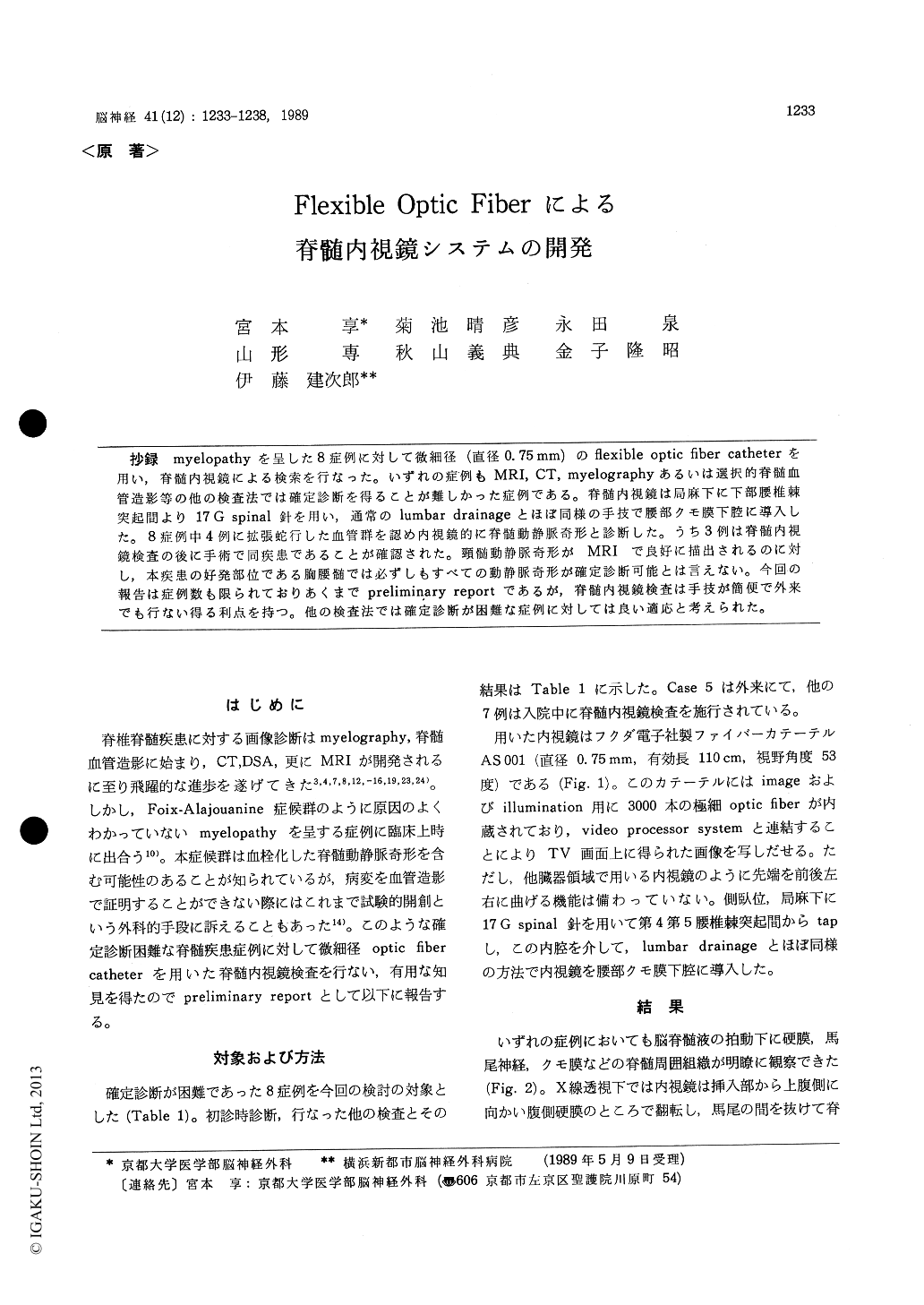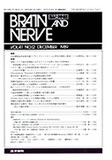Japanese
English
- 有料閲覧
- Abstract 文献概要
- 1ページ目 Look Inside
抄録 myelopathyを呈した8症例に対して微細径(直径0.75 mm)のflexible optic fiber catheterを用い,脊髄内視鏡による検索を行なった。いずれの症例もMRI, CT, myelographyあるいは選択的脊髄血管造影等の他の検査法では確定診断を得ることが難しかった症例である。脊髄内視鏡は局麻下に下部腰椎棘突起間より17G spinal針を用い,通常のlumbar drainageとほぼ同様の手技で腰部クモ膜下腔に導入した。8症例中4例に拡張蛇行した血管群を認め内視鏡的に脊髄動静脈奇形と診断した。うち3例は脊髄内視鏡検査の後に手術で同疾患であることが確認された。頸髄動静脈奇形がMRIで良好に描出されるのに対し,本疾患の好発部位である胸腰髄では必ずしもすべての動静脈奇形が確定診断可能とは言えない。今回の報告は症例数も限られておりあくまでpreliminary reportであるが,脊髄内視鏡検査は手技が簡便で外来でも行ない得る利点を持つ。他の検査法では確定診断が困難な症例に対しては良い適応と考えられた。
The development of spinal endoscope using a thin (0. 75 mm in diameter) flexible fiber catheter AS-001®, Fukuda-densi Co Ltd., Japan) is descri-bed in this study. This fiber catheter contains 3, 000 optic fibers as imaging and illuminating fibers within its diameter. The effective length and the visual angle is 1. 10 m and 53 degree, respectively. Video processor system was connect-ed to this fiber catheter. With a patient in the lateral decubitus position under local anesthesia, this fiber catheter was introduced into the lumbar subarachnoid space in a similar manner as lumbar spinal drainage. Eight patients with meylopathy were evaluated by this spinal endoscopic study. With other radiological diagnostic modalities such as myelography, selective spinal angiography using intraarterial digital subtraction angiography (DSA), or magnetic resonance imaging (MRI), it was difficult to make definitive diagnosis in these8 patients. In 4 patiens among them, vascular tangle, or tortuous course of the dilated vessels were visualized on the dorsal surface of the spinal cord by the spinal endoscopic study, which strong-ly suggested the spinal arteriovenous malforma-tion. In 3 of them, operative findings verified these preoperative endoscopic diagnoses to be correct. In the remaining case, surgical interven-tion was not attempted because of the personal affair of the patient. In every case, several struc-tures around the thoracolumbar cord such as spinal dura mater, arachnoid membrane, or conus medul laris were observed under the pursation of the cerebrospinal fluid. No complication was associ-ated with this spinal endoscopic study. About 10 minutes were required for the whole procedure. The patients were kept in supine position for an hour following the spinal endoscopic study as in a similar manner after lumbar spinal tap. Angiographically occult spinal arteriovenous mal-ormations have been described as Foix-Alajouanine syndrome, which is known to be a partially throm-hosed spinal arteriovenous malformations accord-ing to the operative exploration. In some cases such as Foix-Alajouanine syndrome, conventional diagnostic modalities may fail to demonstrate ac-curately the lesions. This preliminary study shows the technical ease and the possibility of clinical effectiveness of the spinal endoscopic study using a thin flexible optic fiber catheter for evaluating myelopathic lesions that cannot easily be detected by other methods. Because of its technical ease, spinal endoscopic study can be parformed for out-patient. It is impossible to manipulate this endo-scope in a medial-lateral or cranio-caudal direction and its visualization is totally dependent on where the optic fiber catheter goes as it is advanced rostrally. Thus the visualization is limited to the dorsal surface of the spinal cord above the L4/5level. The endoscope cannot be advanced caudally. Thus, the lesions located ventrally to the spinal cord or sacrococxygeal lesions cannot be evaluated by this method. In most cases with spinal arterio-venous malformation, the posterior spinal vein contributes as draining system. Thus dilated pos-terior spinal vein can be detected by the spinal endoscopic study. It is necessary, however, to differentiate it from the engorged vein in cases with spinal cord tumor.

Copyright © 1989, Igaku-Shoin Ltd. All rights reserved.


